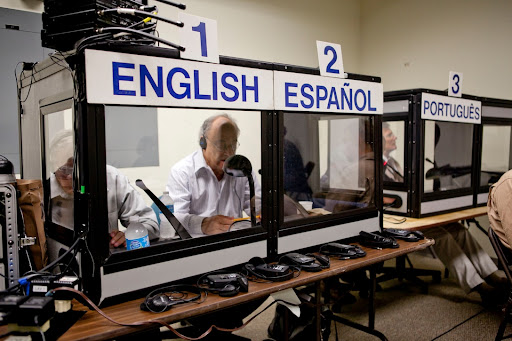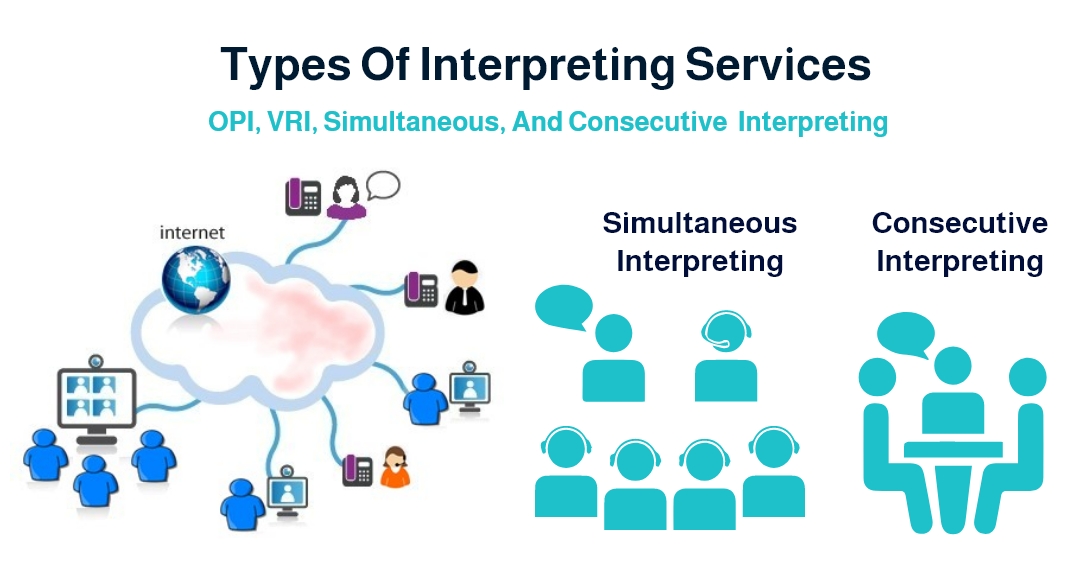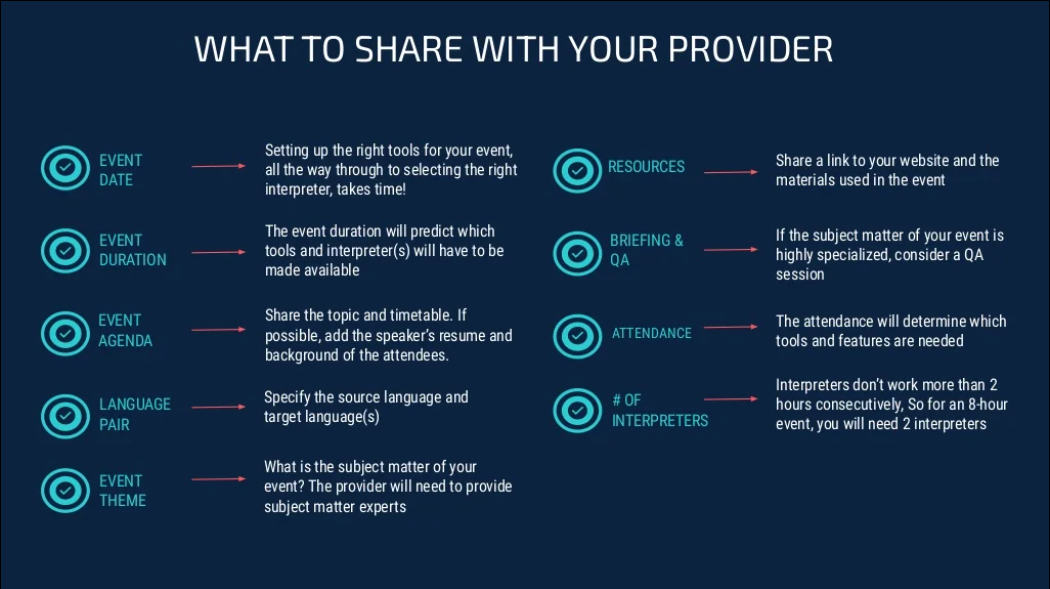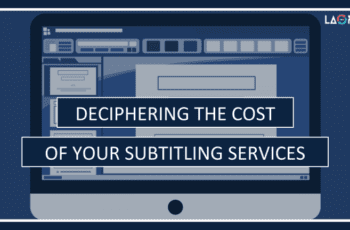A Complete Guide to Types of Interpretation Services: On-Site & Virtual Interpreting
As much as we think that everyone by now speaks English, only 1.5 billion people (less than 20% of the world population) do so, according to Statista, and not in the most proficient way. Let alone the many dialects and other languages that are part of the demographics of each country.
Thus, besides translation, interpreting services are necessary if you want to be able to communicate in a language other than yours and connect with multilingual audiences. In this article, we go through different types of interpretations and their differences to help you establish new partnerships or manage geographically and linguistically versatile teams.
What Are Interpretation Services?
Interpreting means translating a spoken speech or message from one language (the source language) to another. It is performed by interpreters equipped with outstanding language skills, interpreting expertise, and emotional intelligence to facilitate communication between two or more parties when they don’t speak or understand the same language.
After the Second World War, starting with the Nuremberg trials, interpretation has been facilitated by technology as well. Now interpreters can use isolated booths, headsets, and microphones to ensure high-quality interpretation.
Fast forward to 2020, when the Coronavirus hit the world, new ways of defying distance and lockdowns have developed such as virtual interpreting where the interpreter and the other parties do not have to be at the same physical location at all. They only need an Internet connection.
Below, we go into detail about each one!
2 Main Types of Interpretation Services
In this section, we’ll mention two types of interpreting services so you can understand which one you need, and then go more in-depth with the different modes of interpreting available.
1. On-site Interpreting
When interpreting services are provided on-site, the interpreter, speaker, and listeners/audience are all physically present in the same location. Due to the fact that they do not speak the same language, the interpreter must first listen and then orally translate to the audience what the speaker is saying in a clear and accurate manner.On-site interpreting services can be used for business meetings, legal proceedings, medical appointments, conferences, walking tours, etc. Because the audience may not all be speaking the same language, more than one interpreter may be required for the same event. A perfect example of this is the United Nations, where leaders from all over the world gather, each speaking and understanding a different language.
2. Virtual Interpreting
Virtual interpreting, also called remote interpreting, has become even more popular and in demand. The pandemic has changed the world we live in and has created the necessity of virtual workspaces that might necessitate assisted oral translation of cross-lingual conversations.CSA research estimated a 14% growth in remote simultaneous interpreting, and many workspaces and businesses have decided to take advantage of the technology that offers virtual interpreting services, from large conferences to one on one video calls. Two main types of virtual interpreting services are over-the-phone interpretation (OPI) and video remote interpreting (VRI).
-
Over-the-phone Interpreting (OPI)
Telephone interpretation is a three-way phone call where the interpreter translates using consecutive interpreting. It can be used in customer service hotlines and emergencies where one interpreter or the listeners cannot be in the same location. OPI accommodates any schedule or workload because it eliminates the cost and time of commuting, accommodation, and other hassles that come with on-site interpreting.
-
Video Interpreting (VI)
As the name suggests, video interpreting service is a method of providing interpretation through video conferencing technology. Different from over-the-phone interpreting, here, body language, gestures, and other visual cues are possible, helping ensure effective communication. Apart from virtual conference interpreting cases, this type is often the best choice used to facilitate communication for people with hearing impairment.
Download our comprehensive checklist
Get your free guide to help you plan your next virtual interpreting event!
6 Modes of Interpreting and Their Differences
1. Simultaneous Interpreting (SI)
During simultaneous interpreting, the speaker and interpreter work in real-time, and the translation of the speech happens as it is being spoken. The interpreter listens and repeats the heard sentences with no pause in between, with a maximum of a few seconds delay. This saves time and doesn’t disturb the natural flow of the speaker.

The interpreter works from an isolated booth and speaks through a microphone which transfers the sound to the audience in their headsets. As they have minimal time to listen, translate, and reproduce the same speech, professional interpreters are individuals trained to stay focused and productive in a way that might be challenging to ordinary people.
The difference between interpreters and translators is very obvious in this type of interpreting because translators can re-edit and use a lot of tools to help them render words, while the simultaneous interpreter relies on their memory and quick reflexes.
SI is great for speeches, lectures, multilingual business meetings, community gatherings, and presentations.
2. Consecutive Interpreting (CI)
In consecutive interpreting, the interpreter translates chunks of speech after the speaker utters it out. So, the speaker speaks and then pauses, giving the chance for the interpreter to translate. Often this chunk of speech is only a few sentences, but in other more complex topics which cannot be divided into smaller chunks, the pause is longer. In this case, the interpreter has to take notes and can’t rely on their memory only. As such, consecutive interpreting necessitates more time, probably prolonging the meeting.
Consecutive interpreters pay close attention to the whole message before reproducing it in the target language. For longer speeches, they use a specialized system of note-taking such as symbols, abbreviations, and acronyms.Consecutive interpreting might take place in smaller events, where there is no need to talk over the speaker. For example, in a medical setting where the doctor is explaining the procedure needed to be undertaken, the interpreter has to listen carefully and then translate it to the patient or their family.Nonetheless, we must add, CI can also happen in large-scale conferences where equipment like a booth, microphones, and headsets are not available or there is some sort of budget constraints. A hybrid of consecutive interpreting is sight interpreting where the interpreter reads the translated version of the speech. This happens mostly in courts where the speech is already prepared and the wording has to be exact.
3. Travel Interpreting
During travel or escort interpretingservices, the client is accompanied to certain meetings and events and an interpreter assists them by orally translating everything that is going on or any conversation the client indulges in. Travel interpreter oftentimes carries more responsibilities than just interpreting and they can also assist and help the client in many other ways, such as arranging events, checking schedules, and planning parts of the trip.
4. Chuchotage or Whispered Interpreting
How about a situation where the speaker and the listeners move around in different locations where booths are not always available? Whispered interpreting is a type of SI that does not require any equipment; rather, the interpreter sits or stands close to the listener and orally translates in a lower voice. Otherwise called Chutotage, from French, this interpreting technique is common in diplomatic settings, in museums for small audiences, and in relatively quiet settings.
5. Liaison Interpreting
Liaison interpreters act as translators for more than one person in more than one language. Just to put an example of a language pair, in a meeting between a Finnish and a German person, the interpreter must know how to interpret in both Finnish and German. This mode often called bilateral interpreting is a very informal form of interpreting used during business meetings with very few people included. The interpreter has a tricky job since they have to pay attention to every word and be able to fully understand and render everything in two languages.
6. Relay Interpreting
Relay interpreting is an alternative mode of communicating when interpretation between two languages is not possible and a third proxy language is used, which is most commonly a major language such as English. For example, in a big conference where multiple languages are spoken, or the audience comes from a variety of language backgrounds, sometimes the best choice is to interpret everything back to a major language.This can be a more budget-friendly option to host conferences when we’re sure that the audience can clearly understand the proxy language.

How Interpretation Services Are Used in Different Industries
The world has become increasingly global. It’s nearly impossible to not come across someone that doesn’t speak your language even if you were brought up or live in a small town. More so within international business and certain industries that bring together multilingual audiences. As such, interpreting services are an asset of great value to mediate all these conversations.
-
Education and Entertainment
Any type of event or meeting that connects people with common interests but who speak different languages requires interpreting services.Used for:
- Large-scale conferences
- Workshops
- eLearning courses
- Documentaries
- Press Conferences
- International Festivals
-
-
Business, Finance, and Banking
-
The global economy has altered the landscape of doing business; domestic business is now only a minor component of it. Understanding and communicating in English, German, or Arabic is not enough, the world is more diverse than that. Used for:
- Business agreements and
- Formal business meetings
- Meetings to foster genuine relationships
-
-
Healthcare
Medical interpreting services are in high demand since communication between nurses, doctors, and patients is crucial to diagnose, treat, and cure without the risk of malpractice. Language barriers are a real issue in healthcare today with the industry becoming more and more global.
Used for: -
- Consent conversations and agreements
- Discharge instructions
- Consultations
- Diagnosis and treatment instructions
-
-
Legal
Be it in a private meeting, or in the courtroom, legal interpreting is very important, especially in major metropolitan areas. Granting interpretation and translating services to people with limited language proficiency is a human right protected by law.
Used for: -
- Court procedures
- Litigation support
- Witnessing procedures
- Legal consulting
What are the three main steps of interpreting?
- Decide on the type of interpreting that suits your project best: on-site, over-the-phone, or via video. Choose a provider that offers technical support and top-notch quality in the target language through professional interpreters in your industry. You should provide detailed information such as the event date, duration, agenda, language pair, event theme, resources, attendance, and the number of speakers and interpreters.
- Approve the project management’s plan. Go through all the recommendations and the agenda to make sure it fulfills your needs and expectations.
- Stay in close contact with the project management team. Keep communicating with the providers throughout the project and give feedback on what you want to change or improve.
Conclusion
Keep in mind that the interpreting service provider will be representing you and your company, so choose wisely and take your time exploring options. Laoret can handle all of your needs through our impeccable infrastructure, equipment, and a great team of interpreters and experts in all industries. Request a quote today to learn more about how we can best meet your needs.







